Sainte-Mère-Église
La Fière Bridge and Merderet River
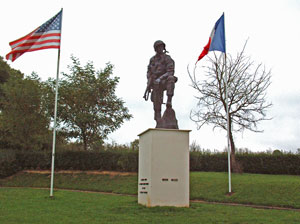
Iron Mike Statue.
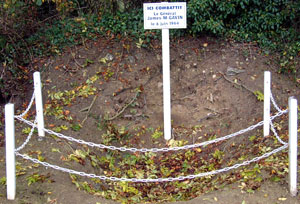
General Gavin's fox hole at La Fière.
The 82nd Airborne Division Astride the Merderet
One of the most confused fights took place west of the village at La Fière Bridge, over the Merderet River. Uncoordinated groups from the 505th, 507th, and 508th regiments hold the position and finally went over the bridge on the 7th. The Monument Iron Mike is overlooking the site, its twin statutes is at Fort Benning. Alongside the road is General Gavin's fox hole. The photo of flooded marshland, a common occurrence that Germans exploited, shows the conditions as they were in 1944.
Merderet Bridge
West of the 101st Airborne the 82d Airborne Division had gained possession of the east bank of the Merderet River in the vicinity of Sainte-Mère-Église. Occupation of these positions, however, actually fell far short of the mission assigned to the division by plan. Broadly, its mission was to assist in sealing off the peninsula from the south by destroying bridges at Pont-l'Abbé and Beuzeville-la-Bastille and securing bridgeheads across the Merderet. Thereafter the 82d was to protect the southwest flank of the Corps by securing the line of the Douve River. It was therefore also charged with taking the offensive to the west in the direction of Saint-Sauveur-le-Vicomte.
The assignments were as follows. The 505th Parachute Infantry was to land east of the Merderet River, capture Sainte-Mère-Église, seize and secure the river crossings near La Fière and Chef-du-Pont, and secure a line in the north running through Neuville-au-Plain and tying in with the 101st Airborne Division in the vicinity of Bandienville or Beuzeville-au-Plain. The 507th and 508th Parachute Infantry Regiments were to land west of the river to consolidate the two bridgeheads o the west bank. More specifically, the 507th was to assist the 505th in securing the La Fière bridgehead and then establish a defensive line running southwest from Gourbesville to Renouf. The 508th was to destroy the crossings of the Douve at Beuzeville-la-Bastille and Pont-l'Abbé and extend the 507th's defensive line south from Renouf. Both regiments were to be prepared to assume the offensive westward and secure the line of the Douve River. All these forces were to land by parachute and were initially under the command of Brig. Gen. James A. Gavin, assistant division commander. General Ridgway, commanding the 82d Division, was to come in with certain glider elements just before dawn on D-Day. The remaining glider artillery and infantry were to follow over a period of thirty-six hours to support the 508th Parachute Infantry in destruction of the Douve bridges. There was also a seaborne force made up of organic and attached artillery, tank destroyers, and other special units under Brig. Gen. Reese M. Howell. The drop of the 82d Airborne Division was far from good. The regiments assigned to the zones west of the Merderet had the worst drop in the entire operation. The 507th Parachute Infantry was to land in Drop Zone T, north of Amfreville, but was scattered widely. The 508th Parachute Infantry was to land southwest of Amfreville and north of Picauville, and had a slightly better drop. But many of its sticks came down east of the Merderet, and for some days many of its men fought with the 101st Airborne Division. In contrast with the other two regiments, the 505th Parachute Infantry, landing northwest of Sainte-Mère-Église between the railroad and the main highway, had one of the best drops of any airborne unit. About 1,000 of the 2,200 men landed in the drop zone, and most of the others, although scattered to the north and east, were able to assemble rapidly. They were fortunate to come down in an area nearly devoid of enemy. Rapid assembly of the regiment enabled it to proceed expeditiously with its mission-one that during the day became more important defensively than the plan has envisaged at La Fière Causeway. The events of Sainte-Mère-Église assumed a greater significance in view of the critical situation which developed along the Merderet. There, more than anywhere else, the well-laid plans miscarried with a far-reaching impact Sacks of 2-pound plastic explosive, point detonated, used as antitank weapons.
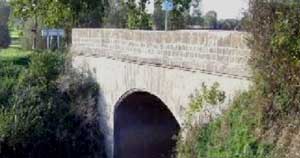
Merderet Bridge.
Securing La Fière and Chef-du-Pont bridges from the east was the assigned mission of the 1st Battalion, both Parachute Infantry. Company A was to seize the one at La Fière. This company, along with the rest of the battalion, had an excellent drop and effected a remarkably rapid assembly, moving to its objective immediately.
On the other side of the river the 507th Parachute Infantry and the 508th Parachute Infantry, with the mission of securing the west bank of the river, probably depended more than any other units on a good drop pattern for success. Both regiments, however, were scattered and faced some of the most difficult problems of assembly of any of the airborne units.


Merderet River.
The two regiments came in between 0230 and 0300, as scheduled. Pathfinders preceding them had in many cases found it impossible to mark the drop zones north of Amfreville and Picauville because of the presence of the enemy. Momentarily puzzled by the failure to see marker lights and by the realization that it was necessary to rely on alternative signals like the Eureka, pilots in some cases overshot the drop zones. Large numbers of paratroopers thus landed in the watery marshes along the Merderet. Aerial photos had indicated that the Merderet was a fairly narrow stream bordered with grassy swampland. But the photos were deceptive in that they did not reveal the wide flood areas created by the closing of the la Barquette lock. Grass had grown out of the water so thickly that from above this shallow lake looked like a prairie. Paratroops, heavily laden with equipment, found themselves in water several feet deep. The whole problem of assembly and recovery of equipment was therefore complicated. Both regiments were also widely dispersed. Part of the 508th Parachute Infantry dropped east of the Merderet and operated with the 101st Airborne Division. The 507th Parachute Infantry dropped generally east of its assigned zone, but personnel were found in widely separated places in the entire peninsula. Small groups held out against the enemy for several days, isolated from the rest of the division.
At first there was a noticeable gravitation to the La Fière bridge area, and ultimately elements of four regiments, including the 325th Glider Infantry, had a hand in the establishment of the bridgehead. This convergence on La Fière was due in part to the tendency of the groups landing in the Merderet marshes to collect at or move toward the railroad. The railroad embankment rose prominently from the marshland and was a convenient orientation feature. The men knew it was the only railroad in the Merderet valley and naturally used it as a guide. Probably the first group to do so was the one led by Capt. F. V. Schwartzwalder. His group of men from the 507th Parachute Infantry had landed along the swamp east of the Merderet and assembled on the railroad embankment. They moved down to the La Fière bridge and met their first opposition there at daylight. In an orchard near the group of houses east of the bridge, they were fired on by mortar and small arms. Several attempts to rush the houses netted only casualties. The engagement thus begun involved, in the course of the day, groups from all three parachute regiments. Company A, 505th Parachute Infantry, which had assembled almost to a man in the drop zone near Sainte-Mère-Église, was already engaged on the right of Captain Schwartzwalder's unit. Next on the scene were men of the 507th and 508th under Col. Roy Lindquist, Commanding Officer, 508th Parachute Infantry. Colonel Lindquist, after landing in the swamps northeast of Amfreville, moved to the railroad embankment, assembling a hundred men as he went along. On reaching the railroad, he was joined by thirty men of the 507th under Lt. John H. Wisner, regimental S-2. Lieutenant Wisner wished to reach the regimental assembly area in the vicinity of Amfreville. Colonel Lindquist's objective was Pont-l'Abbé. Both planned to follow the railroad as the clearest route south, and to cross the river at La Fière if the bridge was taken.
They arrived at dawn at the intersection of the railroad and the highway from Sainte-Mère-Église west, to find Company A, 505th Parachute Infantry, moving toward the bridge. The company was deployed to the north of the road and Colonel Lindquist decided to move up abreast. Lieutenant Wisner's men, leading off, were stopped by machine-gun fire 300 yards east of the bridge. At about the same point Company A, also pinned down by enemy fire, tried unsuccessfully to outflank the German positions from the right. About that time Lieutenant Wisner, reconnoitering to the north, ran across another group making its way to La Fière. This new group numbered about 300 men, principally from the 507th Parachute Infantry, who had assembled, like so many others, north of La Fière and had followed the railroad south. Part had been collected by General Gavin, and part by Lt. Col. Arthur Maloney and Lt. Col. Edwin J. Ostberg. General Gavin's initial intention, after assembly, was to move this force south against the west end of the La Fière bridge and causeway. However, fruitless efforts to retrieve a jeep and an antitank gun from the marshes delayed the move until daylight. With the light, enemy fire seemed to build up along the west bank. The original plan was therefore abandoned and the force proceeded east and thence south along the railroad embankment.
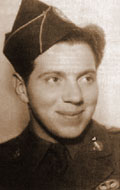
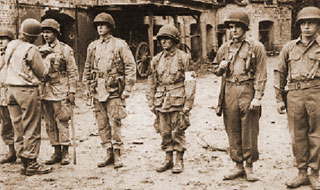
Marcus Heim in 1944
Note the Paratrooper Infantry Regiment Insignia of the 505th on the beret.
Marcus Heim with some of his Comrades and Officers awarded by General Omar Bradley. Marcus is to the right, next to the left is Col. Vanndervoort with a walking stick.
When this force arrived at La Fière, the first American attempt to approach the bridge had been checked, but still it did not appear that the enemy was strong. Moreover, men of the 507th and 508th continued to drift into the position until by midmorning some 500 to 600 had gathered there. General Gavin therefore decided to commit part of the force elsewhere. Colonel Maloney was sent south with seventy-five men to reconnoiter another crossing. A little later General Gavin and Colonel Ostberg took another group of seventy-five men to try to cross the Merderet at the Chef-du-Pont bridge, which had been reported undefended. Colonel Lindquist took command of the assorted units remaining at La Fière. The principal organized groups, comprising about 400 men of all regiments, were Company B, 508th Parachute Infantry; Company G, 507th Parachute Infantry; and Company A, 505th Parachute Infantry. Company G, under Captain Schwartzwalder, in position on the extreme left, south of the road, had probed out the weakest portion of the enemy line but had not followed up the advantage. When Colonel Lindquist ordered an attack at noon by all forces, Company A, which had displaced to the north of the road, failed to get the order, but Lindquist's own force, attacking through the area where Company A had been held all morning, destroyed or captured the last of the enemy. As the fire fell away, Captain Schwartzwalder's men crossed the causeway and made contact near the west end with a patrol from the 2d Battalion, 507th Parachute Infantry (Lt. Col. Charles J. Timmes).
The 2d Battalion, 507th Parachute Infantry, had achieved an early assembly of fifty men under Colonel Timmes 1,000 yards east of Amfreville, near the battalion's planned drop zone. Soon after the initial assembly a patrol under Lt. Lewis Levy of Company D was sent to investigate the La Fière causeway and to clear it if possible. The patrol found a few men of the 507th already established in the village of Canquigny, though enemy infantry held the ground south and east. The forces joined but were unable to work their way to the causeway until the attack from the east bank carried across. The success of that attack cleared the west bank and brought eighty men into the bridgehead. Lieutenant Levy then established contact with the forces still on the east side and received assurance that the 1st Battalion, 505th Parachute Infantry, was coming across to take over the bridge.
The position seemed secure. Yet within the next hour the bridge was lost. The Germans countered quickly. Enemy artillery began to hit the vicinity of Canquigny, while small-arms fire built up to the south; tanks were heard approaching from the west. Before these signs of coming battle had become critical, Captain Schwartzwalder had decided that his primary mission was to go on toward Amfreville to join the 2d Battalion and, under prodding of the first enemy artillery bursts, had pulled out fast with his eighty men and some additional personnel of the 508th. As no other troops from the east bank crossed over, this move left the bridgehead in the hands of four officers (including Lieutenant Levy) and eight enlisted men. With grenades and rifles and one machine gun, this handful of men fought off the enemy and even succeeded in disabling two enemy tanks with Gammon grenades, but they finally had to withdraw northward to join the 2d Battalion of the 507th.
In the meantime, Company B, 508th Parachute Infantry, had been sent, belatedly, across the causeway. When it arrived on the west bank it met the enemy attack head on. Unable to organize or hold its ground, it was forced south along the river, and survivors swam back under fire to the east bank.
The bridge so handily won was thus lost through failure to consolidate rapidly the west bank position. The reason for the failure was in part that the groups participating in the action had only a vague idea of what neighboring units were doing. The hedgerow country virtually penned each unit in its separate field of action.
Not only had the bridge been lost, but the enemy counterattack had isolated the force under Colonel Timmes (now including Captain Schwartwalder's men) from the units at La Fière. Colonel Timmes' group had taken up a defensive position in an orchard near Amfreville and was caught and virtually immobilized by the enemy forces attacking toward the bridgehead. An attack south to La Fière was planned for that night but not attempted. The force numbered about 120 men; many were exhausted or casualties; and, in addition, friendly artillery fire began to fall in the causeway area. Colonel Timmes' force remained isolated in this position for two more days.
At La Fière, after the retreat of Company B, 508th Parachute Infantry, the position on the east bank was reorganized. Men of the 507th and 508th Regiments under Colonel Lindquist were relieved on the left and the remainder of the 1st Battalion, 505th, joined Company A in the line. Colonel Lindquist's men were placed in reserve west of the railroad. But the position was still far from satisfactory. The forward defences of the 1st Battalion, 505th, were exposed to heavy mortar and artillery fire, and the enemy, after his success in clearing the west bank, began to show unusual aggressiveness. Two German tanks attempted to exploit their success by crossing the causeway. Company A's road block covered by bazooka men stopped the attack, destroying both tanks. But it seemed probable that the Germans would try again. General Gavin came up to La Fière from Chef-du-Pont late in the afternoon and found the situation serious. Ammunition was low; medical aid was scarce. General Gavin sent orders to Colonel Maloney at Chef-du-Pont to bring all his force, less about a platoon, to La Fière at once.
Before Colonel Maloney arrived, the enemy attacked the east bank again in considerable strength, and the position of the 1st Battalion, 505th Parachute Infantry, was, in the opinion of its commander, becoming rapidly untenable. At about 2000 Colonel Maloney brought 200 men to La Fière and moved up to the 505th Parachute Infantry line. By dark the American defence was again fairly well stabilized and the enemy had ceased his attack across the causeway.
Locally the situation was secure. But there was still no news at 82d Airborne Division headquarters, located west of Sainte-Mère-Église, of the progress of the seaborne invasion. General Ridgway therefore took steps to provide for the possibility that the whole division might have to consolidate its defence in the vicinity of Sainte-Mère-Église. Colonel Lindquist was ordered to move his force, now numbering some 250 men, to a position from which he could prevent the enemy from cutting off La Fière units from Sainte-Mère-Église. This movement, however, was not accomplished until the next day.
While the chief concern of the 82d Airborne Division during D-Day was with the La Fière bridgehead, where the bulk of the assembled forces were committed and where the enemy put up his strongest resistance, another attempt to secure a crossing of the Merderet River had been made at the same time to the south of Chef-du-Pont and had fared slightly better. The initial attack at Chef-du-Pont had been undertaken by the seventy-five men under Colonel Ostberg. The enemy withdrew from the town and the eastern approaches to the bridge but dug in along the causeway and on the west bank. Though apparently not numerous, the Germans fought tenaciously. Colonel Ostberg's men were stopped at the bridge. The seventy-five reinforcements who arrived later under Colonel Maloney could do nothing to break the deadlock. At about 1700 the Chef-du-Pont force was stripped to a platoon in order to send reinforcements to the hard-pressed paratroopers at La Fière.
The remaining platoon of thirty-four men under Capt. Roy E. Creek almost at once were whittled down to twenty effectives by direct fire from an enemy field piece on the opposite bank. At the same time from seventy- five to one hundred Germans were observed forming on the east bank in some buildings to the left rear of Captain Creek's position. Captain Creek asked for reinforcements. Before they could arrive, immediate help was provided fortuitously by the landing within American lines of a glider carrying a 57-mm. antitank gun and ammunition. The gun was emplaced and fired to neutralize the enemy artillery piece. Nearly one hundred men came down from La Fière shortly thereafter and the enemy threat was removed. With the reinforcements a defensive position was organized to bring greater fire power to bear on the enemy. In a short time the east bank was cleared, and a platoon crossed the bridge and dug in on the other side without opposition. The bridge was secured, though the position remained enfiladed by enemy fire from the Carquebut area.
The capture of Sainte-Mère-Église, and the fights for the Merderet River crossings at La Fière and Chef-du-Pont, together constituted the principal efforts of the 82d Airborne Division on D-Day. But there were also a number of isolated groups of the division which organized themselves west of the Merderet and fought independently-in some cases for four or five days. These isolated groups contributed in some degree to the accomplishment of the division's missions, though they carried on what amounted to fights for survival rather than battles for planned objectives.
Col. George V. Millet, Jr., commanding the 507th Parachute Infantry, collected in the course of D-Day some seventy-five men northwest of Amfreville. But, though he was not more than 1,000 yards from the 2d Battalion, 507th (Colonel Timmes), he made no contact with this battalion or other friendly elements until D plus 4.
Farther south, elements of the 508th Parachute Infantry were having similar experiences. One group, initially led by Lt. Gerald P. Guillot and later by Capt. Jonathan Adams, had one skirmish after another with the enemy, and survived to join the regiment on D plus 5.
The largest force from the 508th Parachute Infantry to assemble west of the Merderet was commanded by Col. Thomas J. B. Shanley (Commanding Officer, 2d Battalion). Colonel Shanley landed near Picauville. He assembled a small group, not large enough to proceed, as he wished, on the mission against the Douve bridge at Pont-l'Abbé. Before noon he established radio contact with Lt. Norman McVicar, who had a force of about sixty men a mile to the northeast, and started out to join this force. He met a patrol from another force off to his left under Maj. Shields Warren, Jr. Junction between these three groups, however, was delayed by enemy pressure on the south, which forced Colonel Shanley's men to engage. It was mid-afternoon before they could free themselves even so far as to choose better ground and organize a defensive position. Before nightfall, however, the enemy had been cleared sufficiently to allow the Shanley, Warren, and McVicar forces to join. But in the meantime Colonel Shanley had learned that the German force which had been trying all afternoon to close in on him had the strength of a battalion, and that more of the enemy was dug in around Pont-l'Abbé. He therefore abandoned the idea of attacking toward the Douve bridge and decided to proceed to the regiment's assembly area, the high ground known as Hill 30, dominating the Chef-du-Pont causeway. At 2300 the entire force, organized into two companies, moved there and improvised an all-around defensive position.
Private first Class Charles N. Deglopper Medal of Honor
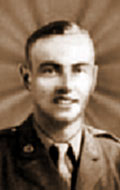
Rank and organization: Private First Class, U.S. Army, Co. C, 325th Glider Infantry, 82d Airborne Division. Place and date: Merderet River at La Fière, France, 9 June 1944. Entered service at: Grand Island, N.Y. Birth: Grand Island, N.Y. G.O. No.: 22, 28 February 1946.
Citation:
He was a member of Company C, 325th Glider Infantry, on 9 June 1944 advancing with the forward platoon to secure a bridgehead across the Merderet River at La Fière, France. At dawn the platoon had penetrated an outer line of machineguns and riflemen, but in so doing had become cut off from the rest of the company. Vastly superior forces began a decimation of the stricken unit and put in motion a flanking maneuver which would have completely exposed the American platoon in a shallow roadside ditch where it had taken cover. Detecting this danger, Pfc. DeGlopper volunteered to support his comrades by fire from his automatic rifle while they attempted a withdrawal through a break in a hedgerow 40 yards to the rear. Scorning a concentration of enemy automatic weapons and rifle fire, he walked from the ditch onto the road in full view of the Germans, and sprayed the hostile positions with assault fire. He was wounded, but he continued firing. Struck again, he started to fall; and yet his grim determination and valiant fighting spirit could not be broken. Kneeling in the roadway, weakened by his grievous wounds, he levelled his heavy weapon against the enemy and fired burst after burst until killed outright. He was successful in drawing the enemy action away from his fellow soldiers, who continued the fight from a more advantageous position and established the first bridgehead over the Merderet. In the area where he made his intrepid stand his comrades later found the ground strewn with dead Germans and many machineguns and automatic weapons which he had knocked out of action. Pfc. DeGlopper's gallant sacrifice and unflinching heroism while facing unsurmountable odds were in great measure responsible for a highly important tactical victory in the Normandy Campaign.